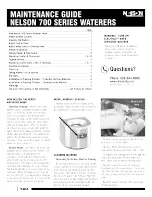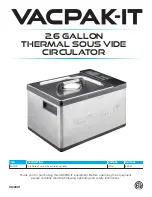
ET 201i DC
0-5452
INSTALLATION
3-9
!
WARNING
Stand to the side of the cylinder opposite the
regulator when opening the cylinder valve. Keep
the cylinder valve between you and the regulator.
For your safety, NEVER STAND IN FRONT OF OR BE-
HIND A REGULATOR WHEN OPENING THE CYLINDER
VALVE!
9. Slowly and carefully open the cylinder valve (Figure
3-5) until the maximum pressure shows on the high
pressure gauge.
Art # A-09828
Figure 3-5: Open Cylinder Valve
10. On all cylinders, except acetylene, open the valve
completely to seal the valve packing. On gaugeless
regulators, the indicator will register the cylinder
contents open.
11. On acetylene cylinders, open the valve 3/4 of a turn
and no more than 1-1/2.
!
WARNING
Acetylene delivery pressure must not exceed 15
PSIG (103 kPa) or 30 PSIG (207 kPa). Acetylene can
dissociate (decompose with explosive violence)
above these pressure limits.
!
CAUTION
Keep the cylinder valve wrench, if one is required,
on the cylinder valve to turn off the cylinder
quickly, if necessary.
12. Attach the desired downstream equipment.
3.08 Leak Testing the System
Leak test the system before putting into operation.
1. Be sure that there is a valve in the downstream
equipment to turn off the gas flow.
2. With the cylinder valve open, adjust the regulator
to deliver the maximum required delivery
pressure.
3. Close the cylinder valve.
4. Turn the adjusting screw/knob counterclockwise
one turn.
a) If the high-pressure gauge reading drops,
there is a leak in the cylinder valve, inlet fitting,
or high-pressure gauge.
b) If the low-pressure gauge drops, there is a
leak in the down stream equipment, hose, hose
fitting, outlet fitting or low-pressure gauge.
Check for leaks using an approved leak detec-
tor solution.
c) If the high-pressure gauge drops and the low-
pressure gauge increases at the same time,
there is a leak in the regulator seat.
d) If the regulator requires service or repair, take
it to a qualified repair technician.
5. Once leak testing has been performed and there
are no leaks in the system, slowly open the
cylinder valve and proceed.
!
WARNING
If a leak has been detected anywhere in the sys-
tem, dis continue use and have the system repaired.
DO NOT use leaking equipment. Do not attempt to
repair a leaking system while the system is under
pressure.
















































